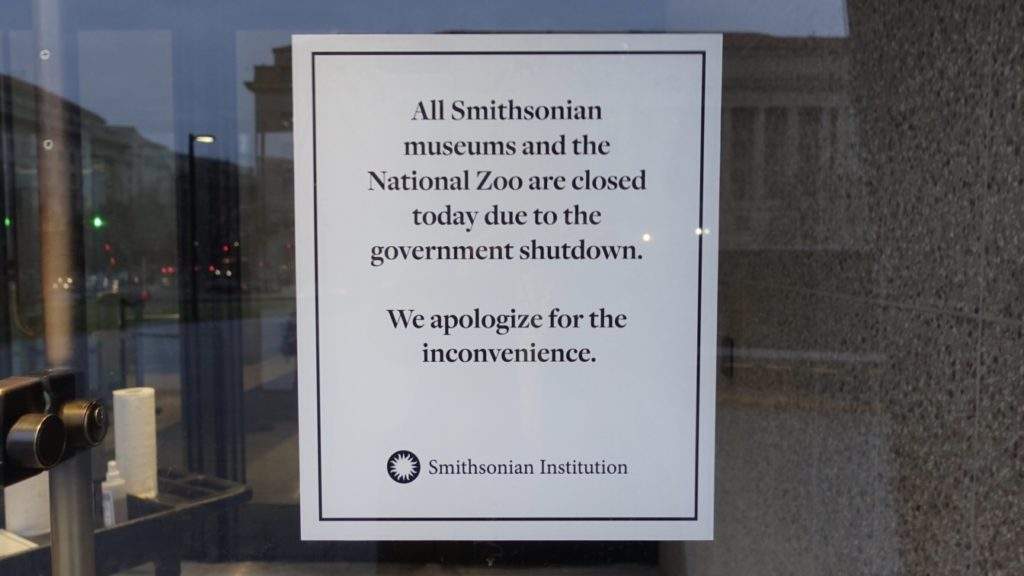The shutdown that has left about eight hundred thousand federal workers in the United States at home since last December 22 is also making its repercussions felt on culture: because of the shutdown, in fact, federally funded museums are also closed, namely the National Gallery in Washington and all the museums that are part of the Smithsonian Institution (from the National Museum of Natural History to the National Air and Space Museum, from the Hirshhorn Museum and Sculpture Garden to the National Museum of AMerican History, not forgetting the National Zoo and the Smithsonian American Art Museum, or the National Portrait Gallery).
A “shutdown” is the total or partial freezing of federal government administration deemed nonessential, and occurs when Congress (i.e., the House) fails to pass the budget bill that distributes appropriations for government activities: if it fails to pass, U.S. law provides for a shutdown. The current one was triggered, as mentioned, on December 22, due to the failure of Congress to approve the funding, requested by President Donald Trump, of $5.7 billion for the construction of the anti-immigrant wall at the border with Mexico. The current shutdown, with its twenty-eight days, is already the longest in U.S. history: never had it lasted nearly a month (the previous record was set by the shutdown that occurred under Bill Clinton’s presidency in 1995, and lasted twenty-one days). The rating agency Standard and Poor’s has estimated that if the shutdown lasts until the end of the month, the bill for the U.S. will be very steep, since it will cost the U.S. economy as much as $6 billion, which is more than the resources Trump has requested for his wall. In addition, the shutdown has important social consequences, because federal employees who are not working will not receive their salaries.
As mentioned above, during the shutdown all government museums are closed and their activities halted: on the website of the National Gallery, a notice appears informing the public that during the shutdown the halls and offices will be closed, orders placed by customers on the museum’s online store will not be processed, emails will not be answered, newsletters will not start, the website will not be updated, and, of course, all programming (exhibitions, lectures, workshops, and so on) is cancelled (or, in some cases, postponed). Not to mention the early closures, such as that of the Rachel Whiteread exhibition, which was forced to close its doors two weeks before the scheduled date.
Museums and all blocked activities will not be allowed to reopen until an agreement is reached between the government and Congress: an agreement that, at the moment, appears unrealizable, since Democrats are adamantly opposed to the wall on the border with Mexico (it is deemed costly, immoral and inefficient), and not even the compromise proposed today by Trump (money for the wall in exchange for a law extending for three years protection for so-called dreamers, i.e., immigrants who entered the U.S. as children following illegal parents) has changed the intentions of Democratic congressmen. And this stalemate is causing major visitor losses for museums: Linda St. Thomas, head of the Smithsonian’s press office, told the Guardian that a month of closure equals the loss of about a million visitors. It is also a devastating loss for the tourism industry in the capital Washington, with tourism boards having to scramble to find viable alternatives for travelers who had planned a trip to the city with the intention of visiting its major museums.
Meanwhile, artnet news magazine reports, several federal museum employees are being forced to find part-time jobs to make up for resources not received during the forced shutdown. For many in fact being affected by shutdown means being in the frustrating situation of not having the money to pay for groceries, bills, insurance, and rent. And there is also to consider that the comeback will not be easy, since lost time and backlog of work will have to be made up. In short: a very difficult situation that everyone hopes will be resolved as soon as possible.
 |
| Washington, National Gallery and Smithsonian closed due to Trump wall shutdown |
Warning: the translation into English of the original Italian article was created using automatic tools. We undertake to review all articles, but we do not guarantee the total absence of inaccuracies in the translation due to the program. You can find the original by clicking on the ITA button. If you find any mistake,please contact us.